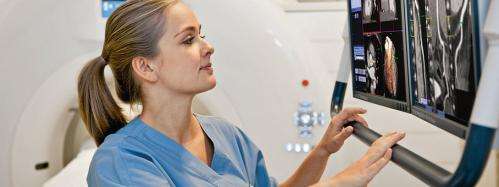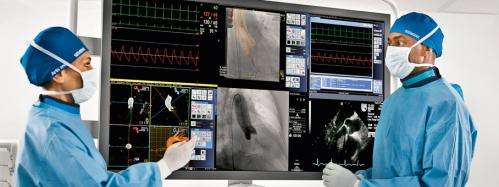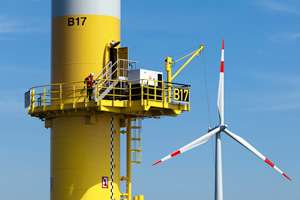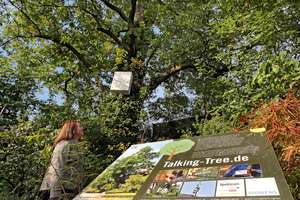The next network

Microcontrollers are everywhere. Essentially tiny computers that are embedded in machines, they supervise a rapidly-expanding universe of functions. In washing machines, for instance, they may access information embedded in electronic tags in clothing labels, allowing them to know whether items are wash-and-wear or wool. Other sensors may tell them how soiled the items are. They may also control water valves, and ensure that the door is securely closed.
Embedded microcontrollers can be found in practically all machines, ranging from DVD players and power tools to automobiles and computed tomography scanners. They differ from PCs in their size and processing power. Embedded systems typically have a microprocessor, a memory, and interfaces with the external world, but they are considerably smaller than their PC counterparts. Frequently, the bulk of the electronic circuitry can be found in a single chip. Although microcontrollers of this sort are tiny, they can easily control even complex machines via their software.
"In a few decades there will be hardly any industrial products that don't have computers inside them," predicted German computer scientist Karl Steinbuch in 1966. His vision has long since become reality, and the global market for embedded systems is now worth approximately €200 billion and is growing fast, according to estimates in a study conducted by the German industry association Bitkom and the Roland Berger management consulting company.
Embedded systems are especially important for Siemens, because these virtually invisible mini-computers are built into almost all the products sold by the company, from medical equipment and automation technology to building management systems, trains, power distribution systems, and turbines.
Like computers, microcontrollers run on software—an area in which Siemens has built up significant expertise. Indeed, the company employs some 17,000 programmers and invests approximately €2 billion per year in software research alone. Nor are Siemens' activities in this area restricted to embedded systems. "After SAP, we're the second largest software company in Europe," says Gerhard Kress from Siemens Corporate Development.
Increasingly, the company's focus in this field is so-called "vertical IT"—information technology solutions that "are specially tailored for individual sectors," explains Kress. He points out that "horizontal IT, on the other hand, is suited to many sectors at the same time. Examples include Microsoft Office programs, as well as software for purchasing, sales, resource scheduling and database management. Siemens doesn't focus on solutions and applications in these areas."
Frequently, vertical IT builds on embedded systems and in the process offers users additional features. For instance, thanks to embedded intelligence, a doctor using a modern CT scanner can view the images created by the machine on a local monitor, or the data can be transferred to a diagnostic software package such as Siemens' syngo.via by means of an integrated external interface. The software helps doctors diagnose conditions by, for example, comparing a patient's latest scans with previous images. "It offers doctors extra value and helps us to sell hardware," says Kress. "In this way, vertical IT becomes a competitive advantage for Siemens."
Customers too benefit from vertical IT's advantages. For example, one automaker has succeeded in cutting its development time almost in half by using end-to-end engineering solutions from Siemens. These solutions included NX software for design, computation, and simulation; Teamcenter software for managing product data throughout the lifecycle; Tecnomatix and Totally Integrated Automation for factory design and the automation of production; and the SIMATIC IT system for real-time processes in its factories.
In parallel with product development, automakers can also use these systems to design new factories, optimize their productivity, and program machines in the virtual world. That saves time and money and avoids errors. In addition, information from manufacturing flows back into the development process, which helps to further improve products.
"The market for horizontal IT is growing by about four percent each year, but vertical IT is expanding at a rate of nine percent," says Kress. That's why vertical IT is at the center of the "Siemens IT revolution," which is designed to tap into new markets that lie between traditional Siemens solutions and horizontal IT.

When Trees Talk. Human beings mastered the global data network (otherwise known as the Internet) a long time ago. Now, machines are beginning to do the same thing. In a trend that is opening up broader horizons in the Internet of Things , intelligent control centers, for instance, are starting to use their interfaces to communicate directly with one another. "We expect that by 2020 there will be 50 billion connected devices," says Ericsson CEO Hans Vestberg. The company has even equipped a tree with an embedded system so that it can send messages to the Internet. "Let's suppose you have a forestry company," says Vestberg. "Wouldn't it be helpful to know how the trees feel?"
In the summer of 2011 Siemens and German science magazine "Spektrum der Wissenschaft" likewise equipped a 150-year-old oak tree in the Botanical Gardens of Erlangen with measurement technology. A particulate matter sensor and an ozone meter record environmental data, with backup from a weather station and a webcam. Thanks to WiFi, the tree sends its data to a computer that evaluates it and can detect how the tree is doing at any given moment. Internet users can take a look for themselves—the "Talking Tree" is active on Facebook and Twitter; it also uploads photos to Flickr and videos to YouTube.
Naturally, there is much more to the Internet of Things than interactive oaks. Indeed, entire wind farms can strike up a machine-to-machine conversation. For example, in one farm, rather than maximizing each turbine's output, Siemens software allows turbines to trade data with a view to maximizing the farm's total yield and minimizing wear and tear on a range of components.
The Internet of Things is also heading for the smart grid. In the future, for instance, energy users such as washing machines, and cooling systems will communicate with the network in order to balance out supply and demand. Siemens and utility company Allgäuer Überlandwerk GmbH have been testing an intelligent electrical grid of this sort for over a year. "The conditions here are like those we expect to see throughout Germany in 2020," says Michael Fiedeldey, Allgäuer's Chief Engineering Officer.

By that time, cars may also be able to communicate with one another and with their environment in order to avoid accidents and optimize traffic flow. If traffic is backed up beyond a curve, for example, cars would warn oncoming vehicles via wireless networks. Machines will thus be talking with other machines in order to save lives.
Revolution in the Making. Many branches of industry are likewise interested in the Internet of Things, because it could lead to a true revolution in manufacturing. This view is shared by advocates of "Industrie 4.0," an initiative that is part of the high-tech strategy of the German federal government and includes Siemens as a participating member. The initiative foresees a scenario characterized by distributed intelligence in which factories no longer require centralized management.

In such a scenario, raw parts and production machines would enter into a dialogue in order to optimize manufacturing processes by themselves. "Each raw product will contain a small embedded system equivalent to a miniature Web server with a wireless interface that serves as its digital product memory," explains Prof. Wolfgang Wahlster, Managing Director of the German Research Center for Artificial Intelligence (DFKI) in Saarbrücken. "The embedded system will know exactly what the raw product is supposed to become, and will independently request the services it requires from individual machines in the factory."
In what could amount to a fourth industrial revolution—following the introduction of mechanical production, mass production using electrical energy, and the electronic automation of production processes—the Internet of Things and decentralized control could make such a high level of flexibility possible that single-piece manufacturing will become profitable. Such a trend could help to safeguard jobs and competitiveness in high-wage countries.
In addition, machines that perform the same duties in factories will be able to flexibly switch from one production run to another without central control system intervention. Wahlster calls this "Plug and Produce," is analogous to the "Plug and Play" technology in PCs.
Siemens is coordinating a European Union project called "Internet of Things at Work," which is designed to make precisely this type of new flexibility possible in production. Within the framework of "Industrie 4.0," the company is also participating in the RES-COM project (resource conservation through context-activated machine-to-machine communication). This project, which is being directed by Wahlster and funded by the German Federal Ministry of Education and Research, is designed to ensure that valuable resources such as energy, water, air, and raw materials are used efficiently.
"But it would be wrong to assume that the Internet of Things is exclusively focused on collecting sensor data," says Joachim Walewski of Siemens Corporate Technology. "Actionable knowledge must be generated from the data." It's not enough, for instance, for a sensor in a materials-handling vehicle to be able to identify a red circle. The system has to know that the vehicle is moving in a certain direction and approaching a traffic light—and it has to draw the right conclusion, in other words, that it's time to brake.
Prof. Michael ten Hompel, the Managing Director of the Fraunhofer Institute for Material Flow and Logistics in Dortmund, likes to compare data packets to freight containers, and refers to "logistics à la Internet." In the future, packages will find their way through logistics networks by themselves, by engaging in negotiations with their environment. "Urgent shipments would then be transported faster, while other packages would have to wait," he says. Embedded systems in containers, equipped with a microprocessor, sensors, and a wireless connection, would not only find the right transport routes but also use temperature sensors to monitor perishable goods, for instance, and thus serve as a product memory.

The "cloud" will play a central role in the future of logistics as well—that is, the idea of accessing processing power, software, and memory on demand via the Internet. "All IT processes for the handling and delivery of freight could be shifted to the cloud," says ten Hompel. "Then an RFID scanner, for instance, would be connected not to a server in a warehouse but to a computer somewhere in the cloud." There, shipments would access a whole marketplace of services as they made their way from their point of origin to a recipient—much like a software module that records the arrival of goods and stores that information in a database. Small applications of this kind could be assembled like Lego blocks into more complex services as needed, and a variety of providers might offer such services.
Services for Everyone. This is precisely the idea behind the "Internet of Services." Here, the global computer network is transformed into a concourse of software modules that can easily be combined to form higher-grade services because they use standardized interfaces. In pursuit of this goal, Michael ten Hompel's institute has already converted a distribution warehouse in Duisburg, Germany to cloud technology.
"Our cloud server offers 31 different 'business objects' as software modules. These range, for example, from warehouse management and receiving. They come from about a dozen different vendors, and it will be easy to combine them, because they all adhere to binding standards," ten Hompel says. The warehouse was ready for business after only two weeks—instead of the months-long lead time that is normally needed.
Tomorrow's Internet of Services may also be able to make our lives easier. Some researchers, for instance, envision an online marketplace that can supply and combine services for everyone. Thus, in the event of a breakdown in a home's heating system, a homeowner would no longer have to arrange visits with workmen. Instead, a call for help on a service platform would be enough. Using semantic technologies, the system would recognize the problem and the seriousness of the situation depending on the season and on weather predictions. The system would then automatically find the right workmen and—based on the calendars of all those involved—coordinate the job. The prerequisite for this is a standardized description of services of the sort provided by the "Unified Service Description Language" (USDL). USDL was developed within the framework of Germany's "Theseus" IT research program in which Siemens played a leading role.
Similarly, autonomous services in the Internet will play an important role in the intelligent electrical grid of the future—in the form of software agents that independently buy and sell energy on behalf of consumers and power producers. Prices on such a virtual power exchange would not depend solely on supply and demand (as is now the case), but would also take into account past experience and forecasts.
In the future, the enormous amount of data on the Internet will become the foundation for new services. There may be services for buildings and homeowners based on patterns of daily electricity demand according to season, services for traffic planners based on traffic volume depending on the time of day, and services for building automation systems based on weather forecasts. For instance, if a building knows ahead of time that a warm front is approaching, it can slowly begin to turn down the heating in advance.
A network augmented with experience can even detect the imminent failure of a component. For example, using thousands of sensors that feed their data to neural networks, gas turbines from Siemens can monitor their own operations in order to optimize the effectiveness of turbines.
Siemens collects this data from approximately 400 plants around the world and uses it to predict wear on parts and to ensure that they are replaced before they break down. Preventive repair instead of a sudden failure—it's to everyone's advantage to give machines a say about what happens!
Provided by Siemens





















